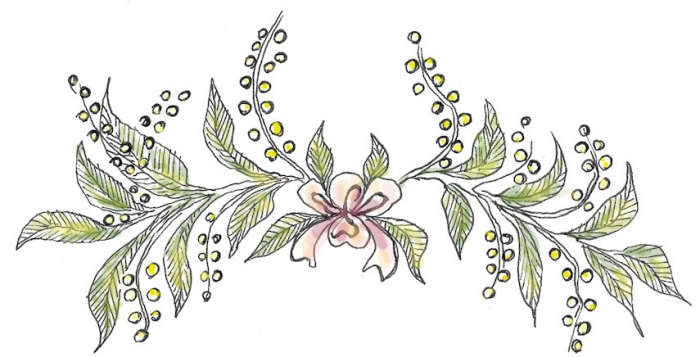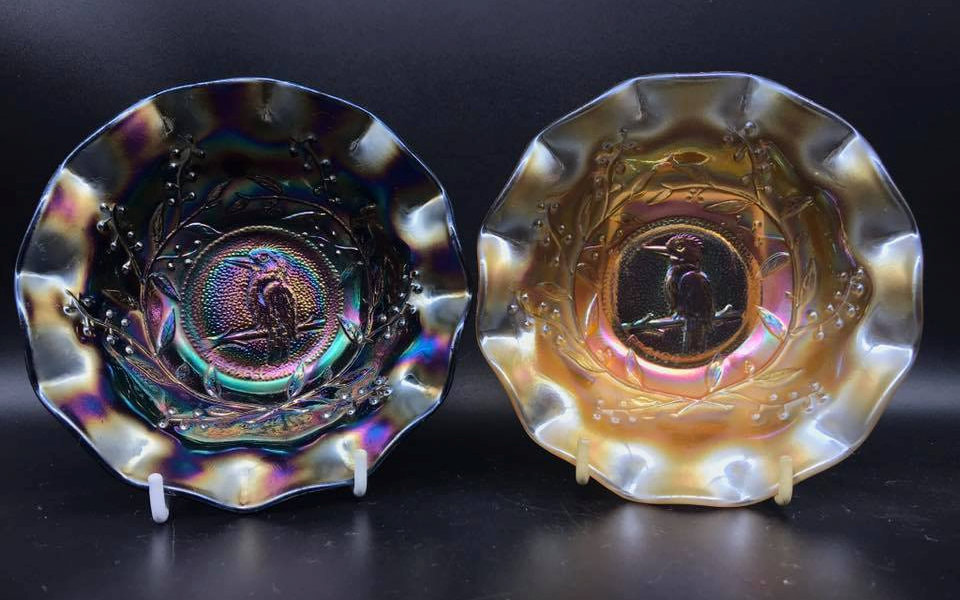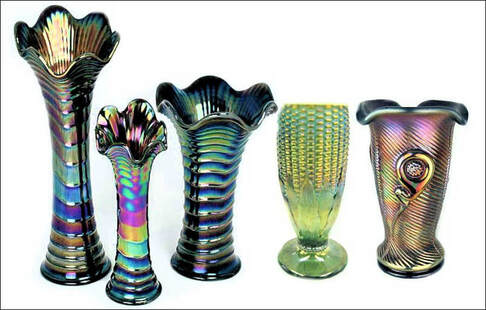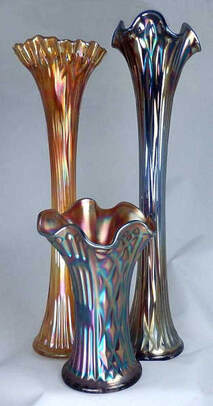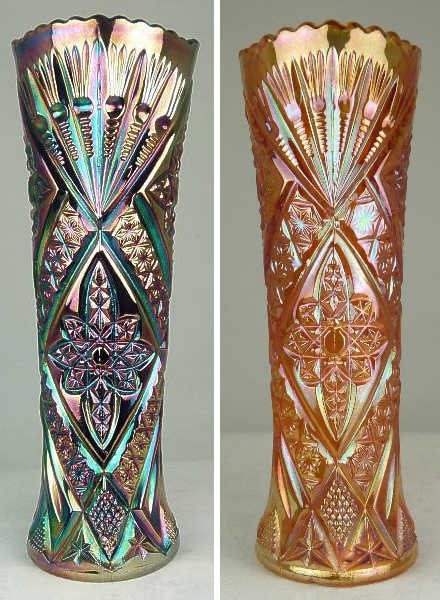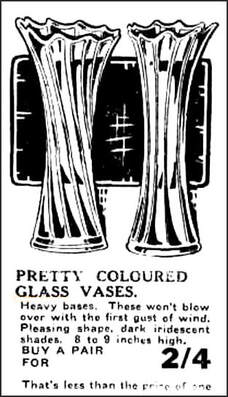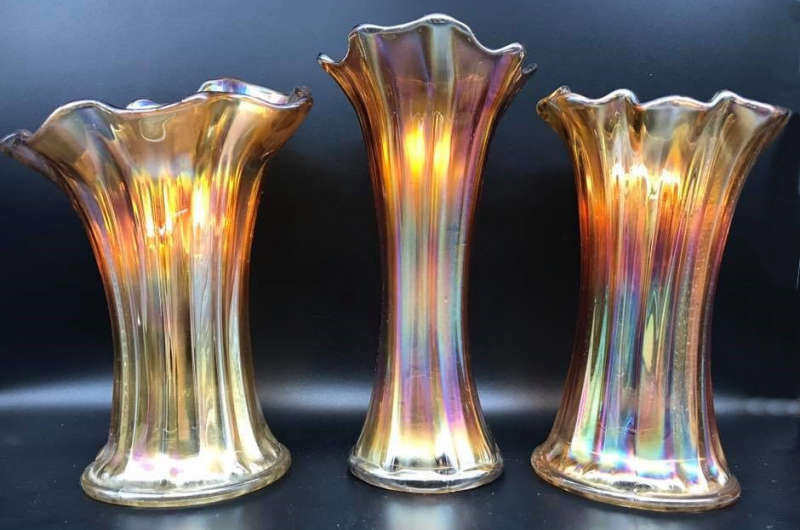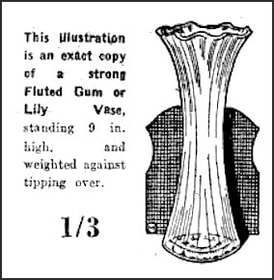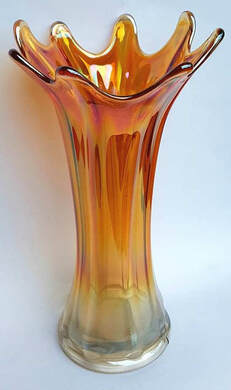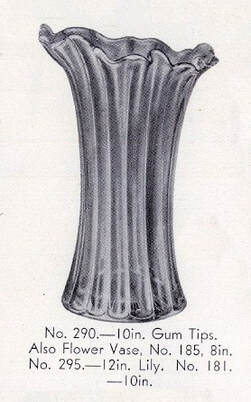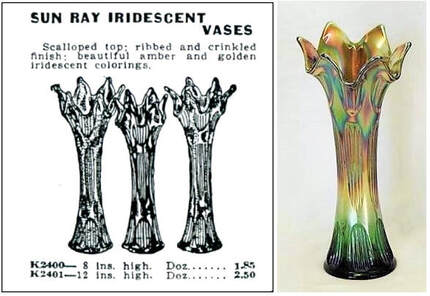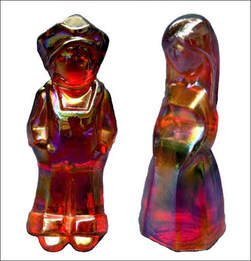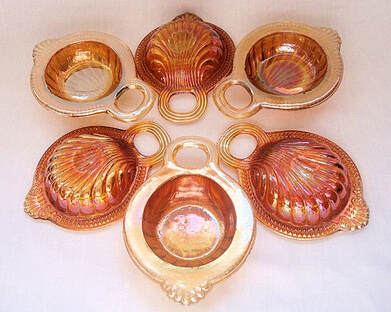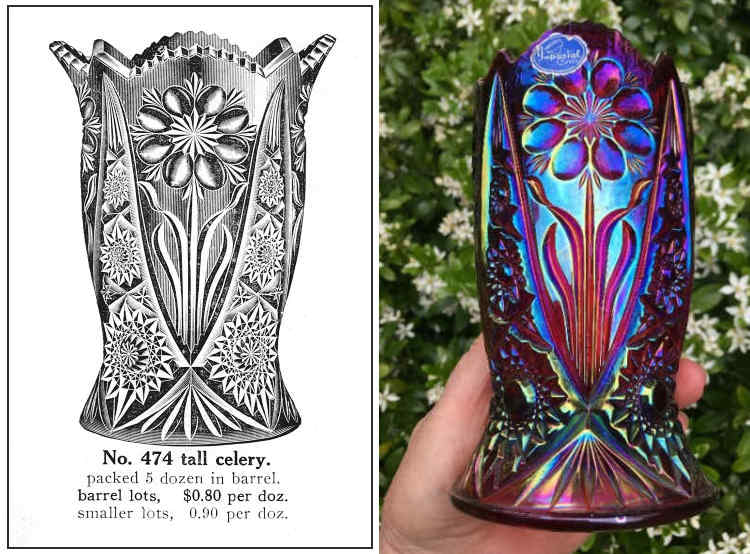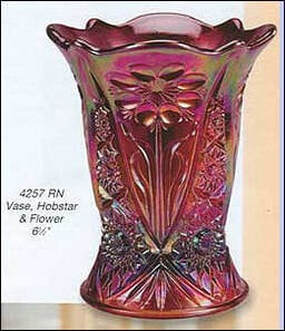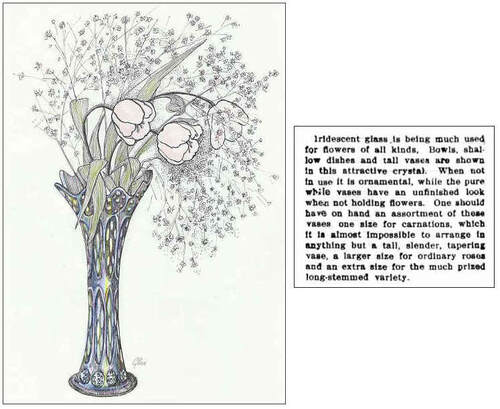NetworK ezine Issue 52. September 2019
Totally Devoted to Carnival Glass
Kingfisher & Kookaburra Masterclass
|
Wattle blossom from Australia.
Never has a country been more beautifully represented in terms of its flora and fauna on Carnival Glass, than Australia by Crown Crystal. One of the most well-known patterns – and probably the earliest one produced – is the Kingfisher – which was lodged as a Registered Design (RD 4184) in 1923. Another favourite is the beautiful Kookaburra. |
Kookaburra Variant small berry bowls (nappies) in dark and marigold.
Courtesy and copyright, Peter Phillips. |
Peter Phillips produced a veritable Masterclass of photos and explanatory text for us (first featured in our Network Facebook Group) to show clearly, how to identify these different (yet similar) patterns, and their variants, as they appear on the small berry bowls (nappies). Shown above is a pair of Kookaburra Variant nappy / berry bowls, in both marigold and purple (Crown Crystal purple or amethyst Carnival is often referred to, simply, as “dark”).
The “Kingfisher Kookaburra Masterclass” is visually intensive, and packed full of detailed photos so that readers can easily identify these beautiful Crown Crystal items. All the images and text can be seen in wonderful detail in this major feature: A Masterclass in Kingfisher and Kookaburra Identification. Our grateful thanks to Peter Phillips for this wonderfully educational, illustrated feature.
|
Vases – a Brief Tutorial
The headline above is from Imperial’s 1912 catalogue (courtesy Jon D. Bartell). Note that vases were being described as “swung vases” at that time. In Imperial’s 1909 catalogue they were described as “swung out, hand finished vases”.
Broadly speaking, there are two kinds of Carnival vases – swung and as-moulded. A swung vase was removed from its mould while very hot, attached to the “snap” (a tool that clamped onto the base / marie of the piece) and was then, quite literally, swung in an arc by the glassmaker, which stretched out the vase. These are the Classic USA Carnival vases that we are so familiar with – examples being Rustic, Tree Trunk, Diamond and Rib, Ripple and so on. The height of the vase depended on the malleability of the glass, and the amount of physical effort applied to the glassmaker's swing. |
The montage above (not precisely to scale) shows three swung Ripple vases and two as-moulded vases – the Corn Vase and a Ribbed Tornado.
|
|
The Classic USA Carnival swung vases are classified by collectors according to their base size:- Mini (or miniature): a base diameter of approximately 2½ inches. Standard: a base diameter from approximately 3 to 3¾ inches. Mid-size: a base diameter ranging from around 3¾ to 4¾ inches. Funeral: Northwood and Fenton funeral vases have a base diameter of approximately 5¼ inches. Imperial funeral vases run slightly smaller at 4¾ to 5 inches. On the immediate right are three Fenton Nine Sixteen vases - they were all made from the same mould (so they all have the same base diameter, that of a "standard" size vase) but they were swung to different heights. The tallest is slightly more than 16 inches! As-moulded vases were, as the name implies, not swung when they were removed from the mould, but left just as they were, with little or no further finishing or shaping. Familiar Classic USA examples are the Corn Vase, Daisy and Drape, Poppy Show, Peoples Vase and so on. Virtually all European Carnival vases were as-moulded*. Familiar examples are Kulor, Pinwheel and Curved Star (two 9 inch examples of which are shown on the far right, in blue and marigold). * Many European vases, especially those from Eda and Riihimaki had a variety of different hand finished shaping to the necks. |
|
Outside the USA, only one maker produced a variety of swung vases in the early Classic era! Australia. Pretty much all the Carnival vases from Europe, South America and others were as-moulded. And the maker of these beautiful Australian swung vases? Crown Crystal.
Two vases – two pattern names – are known. The Lily vase and the Gum Tips vase. Each is known in marigold and “dark” (purple or deep amethyst) as well as non-iridised glass, such as citron (vaseline), pink and blue. The vases were named by Crown Crystal in their catalogues, after the magnificent and showy Australian flora that they were intended to hold. Beautiful, statuesque lilies and in particular, the impressive gum tips (gum blossoms from a wide genus, related to eucalyptus) were very fashionable. A 1925 ad from a Brisbane newspaper which catches the customer’s eye with the line: “Heavy bases. These won’t blow over with the first gust of wind." Note they are also described as “dark iridescent”, and the vase on the left of the pair is twisted.
|
A Crown Crystal Gum Tips vase in the centre, flanked by two Lily vases.
Courtesy Peter Phillips. Note that the Lily vases have a wider base than the Gum Tips vase. These beautiful Lily vases pictured are not swung as much as many others often are. Typically, the Lily vases are swung higher (and thus stand taller) than the narrower-based Gum Tips.
Another ad at the time noted “now that Gum Leaves are taking such an important place in the decorating of the home, a suitable heavy vase is required for safety’s sake”. A vase that was “not easily tipped over” was needed, and Crown Crystal provided exactly that – a vase with a solid and heavy base, as these ads show. |
But which is the Lily vase and which is the Gum Tips?
Both are statuesque, swung vases with an encircling panel or rib pattern, often described in contemporary ads as “fluted” (and no doubt inspired by the earlier Classic USA vases such as Morning Glory, Wide Rib and Spiralex). Crown Crystal themselves were confusing in their cataloguing (giving four different pattern numbers, but only illustrating three) and the advertisers and stores were even worse, often lumping them together as one generic style, as in the ad above. This begs the question, what did the maker actually intend? Were they marketed as a variety of options, rather than very specific, unique items?
Probably, in fact, almost certainly. Catalogues were not intended to be research or study documents, and they were rarely accurate in fine detail.
|
The Lily vase has the largest base at 4¾ inches (12 cm) and they are reported with either 16 or 18 panels or ribs. Lily vases often have a very wide and free-form, ruffled mouth. Gum Tips vases were made in two base sizes, 3¾ inches (9 to 10 cm) and 2¾ inches (7 cm) and are found with either 8 or 10 panels or ribs. (Note: these three base sizes are similar to the USA swung vase classification of funeral, mid-size and standard – however, Australian collectors do not usually apply this categorisation). All three base sizes are found with either a plain or starred base / marie. Gum Tips are also found twisted (either to the right or the left) – this variation would have been done by the glass maker during the “swinging” process. The heights of the vases vary because they were swung, and the hand finishing extended to the mouths too, which were fashioned in a variety of form and ruffling, ranging from incredibly wide with elongated points, to more upright openings. The known Crown Crystal catalogues (from 1929 and 1932) bring both clarification and also confusion! In the 1932 catalogue (far right), a single generic, fluted vase is illustrated with a caption that gives four different numbers, three different names and three different sizes. Despite the vase that is illustrated being captioned "Gum Tips", it certainly doesn’t have only 8 or 10 encircling panels, so it is more likely to be the Lily vase! |
An amazing Gum Tips vase with the flutes on the mouth pulled up much more than is usual. Photo courtesy Gio Sabino Lopez.
|
Extract from the 1932 Crown Crystal catalogue.
|
Iridescent production was not mentioned at that time (1932) and it is likely that these vases were not then being made in Carnival. Instead they were being offered were in “Depression” colours such as pink (rosalin) and vaseline (citron).
The 1929 catalogue is also equally confusing (in different ways) despite actually featuring a full page of iridescent items in which two vases are illustrated. Here is the link to this full page extract from the 1929 Crown Crystal catalogue, in which two vases are illustrated and denoted as "iridescent" and "de lustre" ware (both Carnival): Crown Crystal 1929.
Contemporary newspaper ads are fascinating and very revealing, and perhaps they demonstrate the true picture – that Lily and Gum Tip vases were offered to the customer as a range of heavy based, multi-panelled (fluted) vases in various sizes, and with varying detail. We have assembled an assortment of wonderful newspaper ads from the 1920s - 1930s, and other illustrations of these amazing Crown Crystal vases, here: Australian Press Adverts.
We also have a detailed Collectors Facts page on Lily and Gum Tip vases: Gum Tips and Lily vases.
|
Diamond and Rib -1910 to 1926
In NetworK #51, we showed a glimpse of the Carnival Glass that was on offer in 1910. One of the new vases, just out, and seen in Butler Brothers catalogues as well as Bargain Basements (as featured in the Oregon Daily Journal) was Fenton’s Diamond and Rib vase. It was a popular pattern - offered wholesale at 10 cents each or 92 cents for a dozen (12) by Butler Bros. back in 1910. Now, courtesy of Stan Hoegerman, we show a G. Sommers catalogue image of Diamond and Rib vases, from 1926 – showing that they were being offered for sale over a period of at least 16 years! The artwork in the Sommers catalogue illustration is fascinating, as it interprets the mouths of the vases (and the flutes or flames at the top) in a rather ornate and flamboyant fashion. Most Diamond and Rib vases have somewhat less fancy tops (a little more rounded and less pulled out). However, look at the green vase shown here (courtesy Seeck Auctions) – the flutes are very similar to those in the Sommers ad. |
Above: left an extract from a 1926 G. Sommers catalogue, and right, a Diamond and Rib vase in green, courtesy Seeck Auctions.
|
|
And Now Meet Josh! In NetworK #51, we also introduced you to a Contemporary Carnival figurine called Jenny, courtesy of Joey Aronhalt. Made by Mosser for Vi Hunter, the Jenny figurine had a partner called Josh, who we can now show you, thanks to Don Ruppel. Don tells us that the colour (amberina Carnival) is called “Wildfire”. The figurines were made in 1981 and are signed with the H (for Vi Hunter). Josh and Jenny figurines, photos courtesy Don Ruppel. |
Anyone for Celery?
Imperial’s beautiful La Rochelle pattern (the Original Maker’s Name) is known to most Carnival collectors as Four-Seventy-Four (No. 474), which was the Imperial pattern number for the La Rochelle line. Shown on the left below is an extract from the Imperial 1912 catalogue, courtesy Jon D. Bartell. This celery, made in clear, crystal glass, was part of Imperial’s Nucut line (pressed glass designed to look like cut glass). Note the flared neck on the "No. 474 tall celery".
Imperial’s beautiful La Rochelle pattern (the Original Maker’s Name) is known to most Carnival collectors as Four-Seventy-Four (No. 474), which was the Imperial pattern number for the La Rochelle line. Shown on the left below is an extract from the Imperial 1912 catalogue, courtesy Jon D. Bartell. This celery, made in clear, crystal glass, was part of Imperial’s Nucut line (pressed glass designed to look like cut glass). Note the flared neck on the "No. 474 tall celery".
|
In the 1960s and 1970s, when Imperial began to make Carnival again, one of their old moulds that they revived was an old one from c. 1912 – the tall celery vase in the No. 474 pattern. The original celery mould was re-used to make a Contemporary Carnival vase. In the centre, right, we show it in iridescent Sunset Red - note that unlike the flared out shape of the top on original 1912 celery, the neck on the Contemporary reissue vase is straight and slightly curved-in. So far as we know, this shape was not made in old Classic Carnival. |
The mould had another lease of life: it was subsequently acquired by Fenton who reproduced the vase/ celery, also in Contemporary Carnival. It is shown in Fenton’s 2005 catalogue, pictured above, right (Catalogue extract courtesy of the Fenton Family and Fenton Art Glass Company). It now has a new name , "Hobstar & Flower”. See how the flared neck is similar to the way Imperial originally showed this item in their 1912 catalogue.
We have a major, feature on La Rochelle / Four Seventy Four / Hobstar and Flower, including catalogue images, newspaper ads, and the celery vase mould, here: The Story Behind the Glass - Four Seventy Four.
The mould had another lease of life: it was subsequently acquired by Fenton who reproduced the vase/ celery, also in Contemporary Carnival. It is shown in Fenton’s 2005 catalogue, pictured above, right (Catalogue extract courtesy of the Fenton Family and Fenton Art Glass Company). It now has a new name , "Hobstar & Flower”. See how the flared neck is similar to the way Imperial originally showed this item in their 1912 catalogue.
We have a major, feature on La Rochelle / Four Seventy Four / Hobstar and Flower, including catalogue images, newspaper ads, and the celery vase mould, here: The Story Behind the Glass - Four Seventy Four.
|
A “re-take” of a 1909 view on Carnival vases. “When not in use it is ornamental”. This observation is from a 1909 newspaper article on iridescent glass vases, and it perfectly sums up why we all love Carnival Glass vases. The artwork is a watercolour drawing by Glen Thistlewood, featuring a Fenton Long Thumbprint Hobnail vase. The extract (far right) is from a 1909 New York state newspaper (the “Bolivar Breeze”) advising readers how best to use glass vases and match them to the correct flowers. |
Privacy and the use of your information: we only use your name and email address to send you your FREE Carnival Glass NetworK ezine. We will not share your name or email address with anyone else, or use it for any other purpose. You can change your mind about receiving your NetworK ezine at any time by clicking the unsubscribe link at the foot of every issue, or by emailing us at [email protected]
Join us on Facebook
We invite you and your friends to join us all on NetworK's fast growing and very active Facebook Group (link is below), and if you have missed any of the previous issues of NetworK and NetworK Specials, they are all here: Back Issues.
We invite you and your friends to join us all on NetworK's fast growing and very active Facebook Group (link is below), and if you have missed any of the previous issues of NetworK and NetworK Specials, they are all here: Back Issues.

